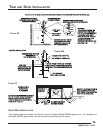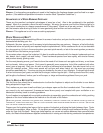
CHIMNEY CAP CHASE INSTALLATION
20
The preinstalled chimney sections should be no more than 13 inches below the top of the chase. The installation
should be planned so that either a two-foot or three-foot chimney section will be used for the top section. This
is necessary to ensure complete engagement of the inlet air telescope and chimney cap into the top section.
1. Extend the chimney sections until the top of the chimney is not more than 13 inches below the top of the
chase.
2. Center the hole in the chase cover over the chimney. The chase cover overhang should be lanced, formed
over the chase and secured with nails. This prevents water from seeping under the chase cover. If two or
more chase covers are to be used on the same chase, they should be soldered together to form two
watertight seams.
3. Place the outer telescope inside the hole in the chase cover and lower it down into the mating pipe of the
chimney until the support brackets on the telescope section rest on the flange of the chase cover.
4. Bend the tab with a hole on each bracket outward and secure cap to flashing, using the tabs provided.
5. Once the telescope is secured, place the rain shield over the top of the telescope pipe assembly. The rain
shield will be supported by the telescope brackets.
C
AUTION: Be careful around electrical wires to avoid the electrical shock hazard of contacting the wires with the
metal chimney components.
N
OTE: When two fireplace chimneys are terminated above the same chase, the centers of the chimney caps
should be at least 24 inches apart to help prevent smoke from a fireplace in use from being drawn down the
chimney of a fireplace that is not in use. Additional spacing between caps or staggering the height of the caps
will further lessen the likelihood of this occurring.
6. Place LCL cap assembly into position by aligning the flue telescope into the last section of flue pipe and
lower it down until the 3 cap legs rest on the top edge of the outer telescope pipe. Secure legs of cap to the
telescope with screws provided.
7. Check all parts of the chimney and chimney cap to assure that no parts have been damaged or bent during
installation and that all parts have been installed properly.
N
OTE: The metal used for the chimney and chimney cap has a rust-protective coating but the cut edges of the
parts are not protected. To prevent rusting and rust staining of nearby structures, exposed parts of the chimney
and chimney cap should be detergent-washed and painted with galvanized primer paint.
2" MIN.
2" MIN.
MAINTAIN 2" MINIMUM AIR SPACE
MAINTAIN 2" MINIMUM AIR SPACE
CLEARANCE TO COMBUSTIBLES
CLEARANCE TO COMBUSTIBLES
ABOVE ROOF LINE.
ABOVE ROOF LINE.
CHASE
CHASE
1 1/2' MIN.
1 1/2' MIN.
OVERLAP
OVERLAP
NOTE: Locally built chase flashings must incoperate
NOTE: Locally built chase flashings must incoperate
a 13-1/4 min. to 13 3/4 max. x 2" high min. flanged
a 13-1/4 min. to 13 3/4 max. x 2" high min. flanged
hole for proper installation of the LCL Chimney Cap.
hole for proper installation of the LCL Chimney Cap.
ROOF LINE
ROOF LINE
OUTER
OUTER
TELESCOPE
TELESCOPE
13" MAX. SPACE BETWEEN CHIMNEY
13" MAX. SPACE BETWEEN CHIMNEY
SECTION AND CHASE COVER.
SECTION AND CHASE COVER.
ON LARGE CHASE TOPS IT IS RECOMMENDED THAT CROSS
ON LARGE CHASE TOPS IT IS RECOMMENDED THAT CROSS
SUPPORTS BE USED TO PROVIDE ADDITIONAL SUPPORT
SUPPORTS BE USED TO PROVIDE ADDITIONAL SUPPORT
TO ELIMINATE SAGGING OF THE FLASHING.
TO ELIMINATE SAGGING OF THE FLASHING.
USING TABS PROVIDED, SECURE OUTER
USING TABS PROVIDED, SECURE OUTER
TELESCOPING TO THE FLAT FLASHING.
TELESCOPING TO THE FLAT FLASHING.
CHASE TOP FLAT FLASHING
CHASE TOP FLAT FLASHING
DOES NOT REQUIRE VENTING
DOES NOT REQUIRE VENTING
OR STANDOFF SPACERS
OR STANDOFF SPACERS
AROUND PERIMETER.
AROUND PERIMETER.
LCL CHIMNEY CAP DESIGN
LCL CHIMNEY CAP DESIGN
INCORPORATES LONGER DUCT
INCORPORATES LONGER DUCT
AND FLUE PIPE FOR CHASE
AND FLUE PIPE FOR CHASE
TYPE INSTALLATION.
TYPE INSTALLATION.
FIGURE 22
53D9028. Rev 1 03/03


















